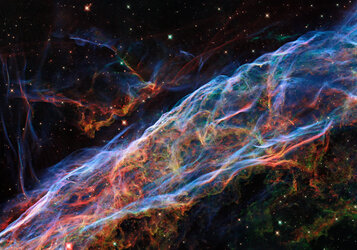

Cosmic silver lining
This Picture of the Week showcases the emission nebula NGC 2313. The bright star V565 — surrounded by four prominent diffraction spikes — illuminates a silvery, fan-shaped veil of gas and dust, while the right half of this image is obscured by a dense cloud of dust. Nebulae with similar shapes — a star accompanied by a bright fan of gas — were once referred to as cometary nebulae, though the name is no longer used.
The language that astronomers use changes as we become better acquainted with the Universe, and astronomical history is littered with now-obsolete phrases to describe objects in the night sky, such as “spiral nebulae” for spiral galaxies or “inferior planets” for Mercury and Venus.
While modern astronomical terminology has become steadily more precise, the nature of objects in astronomical exposures can still occasionally puzzle astronomers. For example, if you look very closely, you can see a faint bluish streak across the centre of this image to the bottom right of the blue region. This could be an asteroid, but seems to be travelling far too quickly for such an object — making this one of the remaining mysteries of the night sky.





